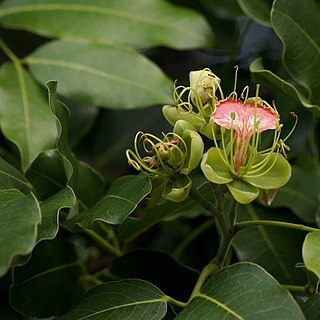A deciduous, medium-sized to large, spreading tree, usually 12-15 m in height but reaching 35 m under ideal conditions; occurring in low-altitude woodland and dry forest. Bark: greyish brown and characteristically flaking in roundish woody scales, leaving pale patches. Leaves: paripinnate; alternate; with 4-6 pairs of opposite to sub-opposite leaflets; leaflets oblong-elliptic, 2-9 x 2-4.5 cm, hairless, shiny dark green above, paler green below, leathery; apex broadly tapering to rounded, sometimes slightly notched; base broadly tapering; margin entire, wavy, with a yellow rim like a halo; petiolules kinked or twisted; petiole 2.5-6 cm long; stipules with a basal section joined which persists as a small scale when the upper section falls away. Flowers: in simple sprays or once-branched racemes; stalks jointed; the bud covered by 2 large bracteoles but these fall before it opens; sepals 4, unequal; a single petal 2.5-4.5 cm long, clawed, expanded, up to 3 cm wide, red with yellow veining; stamens 7, plus 2 staminodes (Jul.-Nov.). Fruit: a large, flat, thickly woody pod, 10-17 cm long, dark brown (Jun.-Nov.). Seeds: up to 6 and occasionally even 10 embedded in a white pith inside the pod, distinctive, dark blackish brown, oblong, up to 3 x 1.2 cm, each with a scarlet to orange aril enveloping the lower third to half.
Tree 1.5–35 m. high, with very spreading crown; bark grey to pale brown, reticulate, or coming off in large flakes leaving yellowish-brown patches; branchlets pubescent, puberulous, or glabrous.. Leaves: rhachis with petiole 6–32 cm. long; leaflets (mature) (3–)4–6(–7 or, fide Roti-Michelozzi, to 9) pairs, petiolulate, ovate-elliptic, oblong-elliptic, or elliptic, 2.3–9(–12) cm. long, 1.5–6.0(–7.2) cm. wide, rounded, or sometimes obtuse, and often emarginate at apex.. Inflorescences erect, of simple or once-forked racemes; axis 2–7.5 cm. long.. Flowers very sweetly scented, with hypanthium 1.1–2.5 cm. long.. Sepals shortly pubescent or puberulous outside, outer 2 elliptic, 0.9–1.7 cm. long, 0.7–1.3 cm. wide, inner 2 obovate-spathulate, 1.7–2.5 cm. long, 0.9–1.8 cm. wide.. Large petal upwardly-turned, 2.5–4.5 cm. long, ± pubescent and green outside, red inside, with a rather long claw suddenly widened into a deeply bilobed lamina 2.2–3.1 (–3.8) cm. wide.. Stamens 7(–9) fertile, with glabrous to pubescent filaments mostly green like the ovary.. Style pubescent or glabrous.. Pods straight, 7–23 cm. long, 4.5–8.3 cm. wide.. Seeds black, oblong-ellipsoid or ellipsoid, 2–3.4 cm. long, 0.9–1.7 cm. wide, with an orange, red, or vermilion, cup-shaped basal aril.. Fig. 22.
A large spreading tree. It is deciduous. It grows 12-15 m high but can reach 35 m high. The bark is greyish-brown and flakes off in round woody scales. This leaves pale patches. The leaves are alternate and compound. There are 4-6 pairs of almost opposite leaflets. The leaflets are oblong and 2.3-9 cm long by 1.5-6 cm wide. They are shiny and dark green above and paler underneath. They taper towards the ends and the edges are wavy. The flowers are in simple sprays. The stalks are jointed. The fruit are large, flat, thickly wooded pods. They are 10-17 cm long. Inside the pod is a white pith. There are 6-10 dark brown seeds up to 3 cm long and 1.2 cm wide. They have a scarlet aril.
Leaves paripinnate; stipules c.9 × 2 mm, narrowly elliptic, upper parts early caducous (only seen in seedling material); petiole 2.5–4(6) cm long, sparsely pubescent, glabrescent; rachis (7)12–19 cm long, almost glabrous; leaflets opposite to subopposite, in (3)4–6(7) pairs, 4–8.5 × 2.5–4.8 cm, broadly ovate to broadly elliptic, almost symmetrical, apex rounded or emarginate, base cuneate, glabrous, usually with a small dot-like gland at proximal side of base either on lower surface in angle between margin and midrib or on the margin itself; venation slightly prominent on both surfaces, marginal vein prominent.
Inflorescences appearing leaf-opposed, usually simple, racemose, 4–7-flowered; axis sparsely to densely puberulous; bracts c.6 × 5 mm, broadly ovate, puberulous, early caducous; bracteoles paired, 6 × 4 mm, broadly ovate, puberulous, caducous; flowers spirally arranged on the axis; pedicel c.5 mm long.
Calyx lobes 4, puberulous outside, glabrous inside, margins sparsely glandular-pilose particularly towards the tip, the outer two c.1.7 × 0.9 cm, broadly triangular, somewhat auriculate at the base, the inner two c.2 × 1.2 cm, broadly ovate, cuneate at the base.
Deciduous tree, up to 20 m high. Pods obliquely oblong, 70-180(-295) x 45-65(-90) mm, compressed. Seeds black, with an orange, red or vermillion, cup shaped basal aril. Flowers green and dark red.
Petal entirely red or green with a red median line, c.3.5 cm long, claw c.2 cm long, pilose near the base, abruptly expanded into a broad bilobed lamina c.2.5 cm wide.
Ovary c.3.5 × 1.5 mm, oblong, pilose particularly on the margins, 10–15-ovulate; stipe c.3 mm long; style c.25 mm long, glabrous; stigma capitate, papillose.
Seeds arranged at right angles to the long axis of the pod, smooth, black, 2.6–3.5 × 1.2–1.7 cm, ellipsoid; aril orange or red, 0.8–1.3 cm long, cup-shaped.
Pod 10–20 × 5–8 cm, straight, oblong, flattened, apiculate, the pedicel attached asymmetrically at the base, glabrous, tardily dehiscent, 5–13-seeded.
Fertile stamens 7–9; staminodes usually 2; filaments c.35 mm long, pilose near the base, otherwise glabrous; anthers dorsifixed>i>.
Germination epigeal; first true leaves opposite, paripinnate, in 4 pairs, elliptic, apex acuminate, base cuneate.
Tree to 25 m tall; bark grey, irregularly fissured, later flaking to leave paler patches.
Hypanthium c.15 mm long, puberulous like the pedicel.
Branchlets brown, sparsely pubescent, glabrescent.


